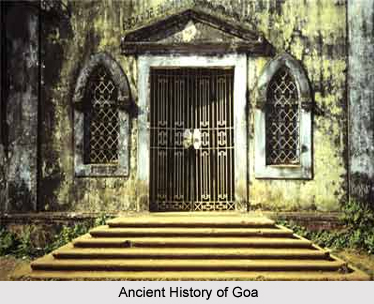 The ancient history of Goa dates back to the 3rd century BC. Goa is a small state lying on the western coast of India. It was a long and treasured history. In Mahabarata Goa has been named as Gomant. According to a legend Parasurama known to be an incarnation of Lord Vishnu shot an arrow into the Arabian Sea from the Western Ghats reclaiming the beautiful land of Gomant. It is also said that once Lord Shiva had stayed in Goa when it was called Gomantak. The area was also known as Govapuri.
The ancient history of Goa dates back to the 3rd century BC. Goa is a small state lying on the western coast of India. It was a long and treasured history. In Mahabarata Goa has been named as Gomant. According to a legend Parasurama known to be an incarnation of Lord Vishnu shot an arrow into the Arabian Sea from the Western Ghats reclaiming the beautiful land of Gomant. It is also said that once Lord Shiva had stayed in Goa when it was called Gomantak. The area was also known as Govapuri.
A small island at the foot of the Western Ghats was earlier known as Goa but the Aryans called it Gomati.
According to the history Chandragupta Maurya had established his empire in Goa. The empire was further enhanced under the rule of his son Ashoka. After the battle of Kalinga, Ashoka took the decision of embracing Buddhism and propagating the message of peace and harmony. During this time Goa was termed as Aparanta, which meant `Beyond the End.` Ashoka sent a Buddhist monk named Puna to proselytize the south, and also Goa. The whole empire gradually acknowledged Buddhism. The rock cut sanctuaries and the relics of several statues stand as a testimony to the continued existence of Buddhism in the region for many years. Ashoka died in 232 BC and the Maurya Empire collapsed almost immediately after him.
For the next few hundred years Goa was not under a stable rule and did not appear as a separate entity.
At the beginning of the fifth century a young Brahmin from the Karnataka went to study at Kanchi, the Pallava capital. He fought with some of the Pallavas and was eventually driven out. Later on his powerful guerrilla attacks against the kingdom forced the Pallavas to agree to an alliance. The young Mayuravarman was thus appointed as the military ruler over the lands from the Arabian Sea to Malwa.
He subsequently established the Kadamba dynasty which ruled Konkan for several centuries. During the sixth century Deccan once again came under unitary rule of the Chalukyas. The Kadambas after conquering Banavasi and the other Kadamba domains were content to remain as local chieftains under the Chalukyan kings.
In 752 AD, the Konkan, along with the Chalukya Dynasty, were over powered by the Rashtrakutas. This dynasty originated in the region of Goa and they named themselves as Lords of Lattalura town.
The ruling Rashtrakuta later transferred the governorship of Banavasi to his brother-in-law thus depriving the Kadambas of their power. Subsequently a descendant of the former Chalukyan dynasty annexed the Rashtrakutas in 973 AD and re-established the Chalukyan Empire in the Deccan for the next two hundred years. One of the Kadambas during this time seized the opportunity to restore his dynasty. He next ruled as Shastadeva I over Gove, or modern Goa. The Chalukyas thus ruled over Deccan and south Konkan was ruled from Banavasi. The Kadambas were left to govern Goa.
During the later period of Rashtrakuta, Konkan had been ruled by a dynasty called Silahara. The Silaharas governed Goa from Chandrapura, modern Chandor. Shastadeva utilised this town as his capital. An inscription during the time of Shastadeva illustrates the town being a pleasing place to live in.
The beautiful natural harbours of Goa had long been acknowledged by traders particularly by the Arabs. In India their main ports were in Gujarat, Goa, and Calicut (Kozhikode). These ports served as the main entrance for importing or exporting of goods. The advantages of Goa`s harbours were not only appreciated by foreign traders, but also Shastadeva himself had a powerful fleet which he apparently sent as far as Ceylon to levy tribute from `the grim barbarian tribes`. It was during this period in which the influence of India was extremely widespread. Hindu kingdoms were established in many places like in Malaya, in Cambodia, in Indo-China. All of these countries naturally looked towards India as their lodestar and trade between them was considerable, in all of which Goa was superbly placed to play an important role.During all this period Goa prospered and traded not only with the neighbouring states but with all the different countries and nationalities that were attracted by the riches of the Indian market.






